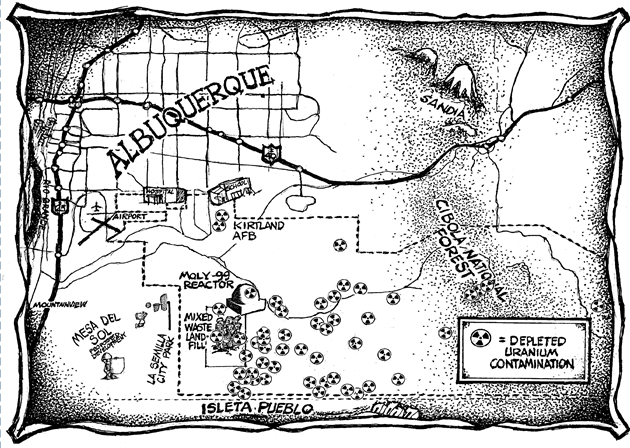
Citizen Action (through New Mexico Community Foundation)
Files
Download Full Text (1.1 MB)
Document Type
Article
Date
3-2004
Description
The Mixed Waste Landfill (MWL) covers 2.6 acres of technical area 3 at Sandia National Laboratories (SNL). It is approximately 5 miles southeast of Albuquerque International Sunport, at the edge of the rapidly developing city of Albuquerque. The region is arid. An aquifer approximately 460 feet below the MWL is the source for Albuquerque’s public drinking water. The landfill was operational from March 1959 to December 1988, accepting wastes from both SNL and other sites. The inventory of wastes deposited in the landfill from 1959 to 1964 is still classified by the Department of Energy and is unavailable. The wastes were disposed of in shallow unlined pits and trenches and covered in soil. Some of the pits in the classified area were capped with concrete. The surface area above some of the pits in the classified area currently have very high gamma rates, as reported in the RCRA Facility Investigation Phase 2 Report. These readings cannot be explained by the known inventory compiled by SNL. The known inventory includes at least 6,300 Ci of radioactivity at the time of disposal, as well as many nonradiological hazardous materials including metals and volatile organic contaminants (VOCs). It is suspected by citizen’s groups that spent oxide reactor fuels that should be considered high level waste (HLW) are buried in the classified area of the MWL, although this has been so far denied by Sandia/DOE and the NMED.
In September 1996, Sandia/DOE published the Report of the Mixed Waste Landfill Phase 2 RCRA Facility Investigation. This report included measurements of radionuclides, metals, and VOCs in the soil underneath the landfill and in groundwater. It also included measurements of tritium levels in soil and of tritium flux from the soil. The Phase 2 report concludes that tritium is the primary constituent of concern, although many other hazardous compounds were measured in soils and groundwater. The Phase 2 report was plagued by data analysis problems—many measurements that found unusually high levels of contaminants were discounted due to unidentified laboratory error, although measurements that found low levels were never discounted. The Phase 2 report contains a baseline risk assessment, which was heavily criticized by citizens groups and was eventually retracted by Sandia/DOE.
The Corrective Measures Study (CMS) is based on the information presented in the Phase 2 report and the preceding Phase 1 report, as well as other measurements made at the site, but does not include any new environmental data. The study states, “The purpose of the CMS is to identify and screen, develop, and evaluate potential corrective measures alternatives and recommend the corrective measure(s) action to be taken at the MWL”.
This research was completed money allocated during Round 4 of the Citizens’ Monitoring and Technical Assessment Fund (MTA Fund). Clark University was named conservator of these works.
If you have any questions or concerns please contact us at digitalrepository@clarku.edu
Publisher
Citizen Action (through New Mexico Community Foundation)
Format
Keywords
nuclear weapons, nuclear weapons testing, environment, non-governmental organizations, United States Department of Energy, tribal governments, environmental cleanup, radioactive fallout, radioactive waste
Rights
Copyright belongs to the authors. Clark University was chosen by the non-profit peace and environmental groups as the conservator of these reports; our right to distribute these works ensures they remain available to the public in perpetuity as intended. Reuse at your own discretion with with due deference to copyright holders.
Location
Santa Fe, NM
Recommended Citation
Citizen Action (through New Mexico Community Foundation); Schneider, Amanda; and Resnikoff, Ph.D., Marvin, "Independent Evaluation of the Corrective Measures Study, Mixed Waste Landfill, Sandia National Laboratories" (2004). Citizen Action (through New Mexico Community Foundation). 7.
https://commons.clarku.edu/citizenaction/7



